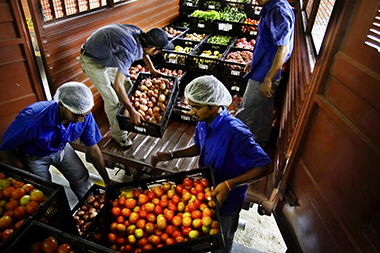The recently adopted UN Sustainable Development Goals (SDGs) prioritize improved nutrition and environmental sustainability. Chapter 6 of the 2016 Global Food Policy Report highlights the need to reach this goal by adapting food systems to support nutritious and sustainably-produced diets throughout the world.
Rising incomes and changing food demand are increasing stress on existing food systems and the natural resource base upon which they depend. In addition, present food systems are not providing foods that support improved health and nutrition. Undernutrition and micronutrient deficiencies exist among a significant share of the world’s poor, yet simultaneously the proportion of people who are overweight or obese is growing in almost every country. To solve these problems, greater efforts are needed to foster the consumption of nutritious foods among populations not currently able to afford a healthy diet, while reducing the demand for unhealthy, low-nutrient foods and foods developed through unsustainable supply chains.
Value chain analysis—an approach that examines each step from production to consumption—provides an inclusive framework for characterizing many dimensions of a food system, including agricultural production, the diversity of food supply, and food affordability. Shifting production and consumption toward more sustainable and nutritious foods requires an understanding of the complex range of factors at work in food value chains, including those affecting agricultural production, price transmission through the chain, and demand for healthier or more nutritious foods.
Food is stored, distributed, processed, marketed, prepared, and consumed in a range of ways that affect its access, acceptability, and nutritional quality. One or multiple points along the food value chain may prevent nutritious products from getting to consumers. To make diets more nutritious and sustainable, it is important to first understand the context-specific constraints and opportunities at the level of small-scale farmers, farmer organizations, and local businesses, so interventions can support more efficient policies to enable sustainability and long term growth. A focus on gender roles also can play a significant role in making nutritious and sustainable value chain interventions successful, but the relationship is complex, as involvement in commercial agriculture or nonfarm income-generating activities may leave women with less time to care for their children.
Value chain interventions can be divided into four categories based on the profile of supply and demand for nutritious foods (Figure 1 below). The typology identifies the entry points where value chain interventions can achieve the greatest nutritional impacts for particular situations, and similarly can be used to analyze sustainability goals. It notes four types of situations (A-D) that can be used to characterize the constraints and opportunities of a particular environment:
- When both demand and supply exist for nutritious food, interventions should focus on optimizing the nutrient flow along the value chain. This implies maximizing efficiency and minimizing waste in the existing chain, while maintaining or enhancing the nutritional content of foods.
- When ample demand for specific nutritious foods exists but supply is limited−possibly because of poor production practices, a lack of infrastructure/high transaction costs, or a lack of trust among actors in the value chain−interventions should aim to improve production practices, organize production and postharvest activities to increase efficiency, and facilitate the expansion of market opportunities to enhance supply.
- When both supply and demand for diverse foods are weak, intensive investments will be required on both the production and consumption sides. Introducing new types of nutritious foods can address this situation but interventions must develop a stable source of supply and promote demand for the new food.
- When nutritious foods are widely produced but not consumed by the target populations either because of habit or relative costs, interventions should focus on changes in consumption, health, and nutrition practices. Demand can be created directly, for example through food transfers or public procurement programs such as school meals, or indirectly, for example, by attempting to increase demand for nutritious foods through mass media or behavioral change communication (BCC).
Other supply-side interventions can provide quality assurance and improved regulatory frameworks, or enhance information flows along the chain. These interventions aim to improve supply by increasing efficiency or boost demand by increasing consumers’ knowledge and willingness to pay for nutritious and safe foods. Success is more likely when these interventions are supported by government regulation and implemented with private sector participation.
Achieving the SDGs will require timely interventions that improve nutrition and ensure sustainability. A number of challenges must be addressed, including filling knowledge gaps, managing trade-offs among goals, and engaging the private sector in support of improved diets and sustainability.
Value chains provide a unique framework to identify the trade-offs and complementarities among the goals of higher incomes, better nutrition, and improved sustainability. Meeting global goals for nutrition and sustainability will require joint solutions that are tailored to diverse situations. Value chain analysis can provide a promising framework for understanding effective interventions to achieve both better health and environmental outcomes.
Summer Allen is a research coordinator and Alan de Brauw is a senior research fellow in IFPRI’s Markets, Trade, and Institutions Division, and Aulo Gelli is a senior scientist in IFPRI’s Poverty, Health, and Nutrition Division. Together, they authored Chapter 6 of the 2016 Global Food Policy Report, titled “Nutrition and sustainability: Harnessing value chains to improve food systems.”







